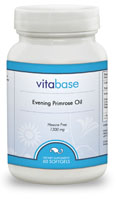| |
Evening primrose oil |
|
| Evening primrose oil (EPO) is derived from the seeds of the evening primrose plant also known as Oenthera biennis. Evening primrose (Oenothera biennis) is a tall, hardy, native biennial of the Onagraceae family. Evening primrose can be found in many parts of North America and are native in the northern temperate zone, especially at high altitudes. Evening primrose is a biennial plant with numerous, crinkled, lance-shaped leaves and green stems with red splotches. Its hermaphrodite pale yellow flowers (for most of the summer - from June to September - reaching a height of 3 to 4 feet) open in the evening, hence the name "evening primrose", are pollinated by Lepidoptera (Moths and Butterflies) and bees. This biennial herb produces only leaves the first year and bright yellow flowers and seeds the second year. Flowers bloom after sunset, June through September, or on overcast days during the second year. Stems are branched, with alternate leaves. Evening primrose is also known as evening primrose, night willow herb, evening star, fever plant, field primrose, King's cure all, scabish, tree primrose, primrose, moth's moonflower. |
| |
Active constituents of evening primrose oil |
|
| Evening primrose oil is a rich source of the long-chain fatty acid gamma-linolenic acid (GLA). Evening primrose oil seeds contain up to 25% essential fatty acids including linoleic acid (LA) and gamma-linolenic acid (GLA). Evening primrose oil contains 74% linoleic acid, 11% oleic acid, 6% palmitic acid, 2% stearic acid, and 9% gamma-linolenic acid. Gamma-linolenic acid (GLA) is a precursor of prostaglandin E1. GLA is used to produce series one prostaglandins such as prostaglandin E1 (PGE1) while EPA is used to produce prostaglandin E3 (PGE3). Prostaglandins thus act on a variety of cells such as vascular smooth muscle cells causing constriction or dilation, on platelets causing aggregation or disaggregation and on spinal neurons causing pain. Prostaglandins affect the function of virtually every system in the body. These molecules are used in the regulation of inflammation, pain, blood pressure, fluid balance, blood clotting, and affect hormone production and function. Prostaglandins act principally on a subfamily of G protein coupled receptors. Prostaglandins have a wide variety of actions but most cause muscular constriction and mediate inflammation. Other effects include calcium movement, hormone regulation and cell growth control. PGE1 has anti-inflammatory properties and may also act as a blood thinner and blood vessel dilator. Without adequate amounts of GLA and EPA, prostaglandin production will be reduced, and problems will result. |
| |
Medicinal uses and health benefits of evening primrose oil |
|
| Evening primrose has a long history of medicinal use, originally by the North American Indians. Evening primrose oil (EPO) has
been used for the treatment of allergy-induced eczema, premenstrual syndrome (PMS), mastalgia (breast pain and tenderness), diabetic neuropathy, rheumatoid arthritis, osteoporosis, acute respiratory distress syndrome (ARDS), hypertension and elevated serum lipids.
Gamma-linolenic acid in evening primrose oil can help to lessen menstrual cramps. It may also minimize premenstrual breast tenderness, irritable bowel flare-ups, and carbohydrate cravings, and help to control endometriosis-associated inflammation. Women with PMS may have a deficiency of PGE1, at the central nervous system and in other tissue such as breast tissue. GLA in the form of evening primrose oil was found to reduce the maximum number of nighttime flushing associated with menopause.
Evening primrose oil appears to be effective in some cases of rheumatoid arthritis and may be indicated in some other inflammatory disorders, such as Sjogren's syndrome and ulcerative colitis. Essential fatty acids increase calcium absorption from the gut, reduce urinary excretion of calcium, increase calcium that is deposited in the bone and improve the strength of bone. Gamma-linolenic acid in evening primrose oil reduces the excretion of calcium, inhibit bone reabsorption and markers of bone turnover, while increasing the levels of calcium content in the bone.
Evening primrose oil is also used to relieve the itchiness associated with certain skin conditions. Evening primrose oil has superb moisturizing properties and is believed to be effective in helping with eczema and psoriasis. Nutritional supplementation of GLA is one of the most important tools in treating eczema and moisturizing the skin and protecting it from environmental oxidative damage.
|
| |
Dosage and administration of evening primrose oil |
|
| For atopic dermatitis or eczema, take a dose of 4 to 8 grams daily, divided into two doses. Doses used for the management of rheumatoid arthritis range from about 360 milligrams to 2.8 grams daily in divided doses. For breast pain (mastalgia), the recommended dosage is 3 to 4 grams daily, divided into two doses. For skin rash, the recommended total daily dosage for adults is 6 to 8 grams. |
| |
Side effects, precautions, interactions |
|
| People at risk of seizures should avoid using evening primrose oil. Evening primrose oil may increase the risk of temporal lobe epilepsy in schizophrenic patients taking phenothiazine epileptogenic drugs. Taking large amounts of evening primrose oil may also cause loose stools. Interactions may occur between EPO and warfarin, aspirin and NSAIDs. |
|
|
|
|
 Vitabase Evening Primrose Oil 1300 mg is 100% pure cold expeller pressed and is free from the dangerous chemical Hexane used by some manufacturers. Take one softgel two or three times daily with meals. GLA is an Omega 6 fatty acid. For maximum benefit consider adding Omega 3 fatty acids to your diet. Click here for more information.
Vitabase Evening Primrose Oil 1300 mg is 100% pure cold expeller pressed and is free from the dangerous chemical Hexane used by some manufacturers. Take one softgel two or three times daily with meals. GLA is an Omega 6 fatty acid. For maximum benefit consider adding Omega 3 fatty acids to your diet. Click here for more information.